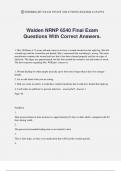Exam (elaborations)
Walden NRNP 6540 Final Exam Questions With Correct Answers.
- Course
- Institution
©THEBRIGHT EXAM STUDY SOLUTIONS 8/22/2024 12:54 PM Walden NRNP 6540 Final Exam Questions With Correct Answers. 1. Mrs. Williams is 76 years old and comes in to have a wound checked on her right leg. She fell a month ago and the wound has not healed. She is concerned that something is wrong. Th...
[Show more]



